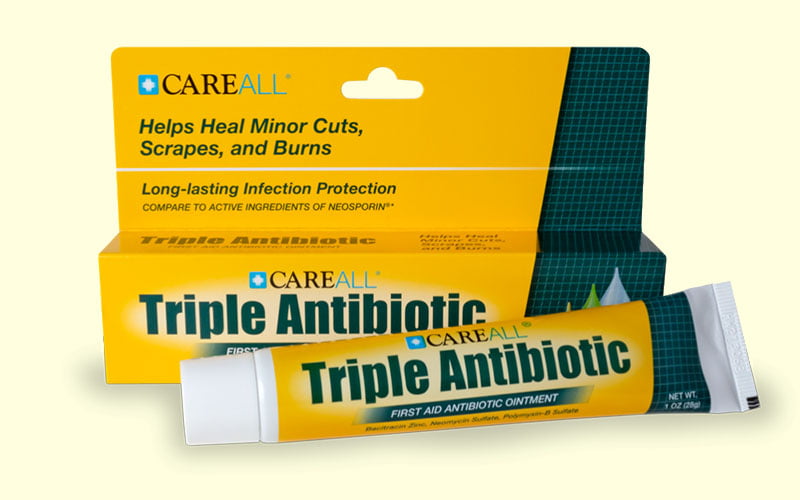Triple Antibiotic Ointment: Guide to Healing Wounds Faster
Introduction
When it comes to minor cuts, scrapes, and burns, having a reliable and effective solution for wound care is crucial. Triple antibiotic ointment has been a go-to product for many years, providing a powerful combination of three antibiotics to help prevent infection and promote faster healing. We will talk about its uses, benefits, and potential side effects. Whether you’re a parent looking to protect your child’s skinned knee or an outdoor enthusiast seeking first aid for unexpected injuries, understanding the ins and outs will equip you to handle minor wounds with confidence.
Key Ingredients of Triple Antibiotic Ointment
- Bacitracin: This antibiotic works by interfering with the synthesis of bacterial cell walls, inhibiting bacterial growth and preventing infection.
- Neomycin: Neomycin is effective against a broad spectrum of bacteria, working by disrupting the protein synthesis of bacteria and preventing them from multiplying.
- Polymyxin B: Polymyxin B targets Gram-negative bacteria and works by damaging their cell membranes, ultimately leading to bacterial death.
The Benefits of Triple Antibiotic Ointment
Triple antibiotic ointment offers several benefits that make it a staple in every first-aid kit. Let’s explore these advantages:
- Infection Prevention: The primary function of triple antibiotic ointment is to prevent infections in minor wounds. By creating a protective barrier over the injured area, the ointment prevents bacteria from entering and causing infections that can further complicate the healing process.
- Fast Healing: With the combined power of three antibiotics, the ointment accelerates the body’s natural healing process. It promotes cell regeneration and tissue repair, helping wounds to close faster and reducing the risk of scarring.
- Versatility: Triple antibiotic ointment is versatile and can be used for a variety of minor skin injuries, including cuts, scrapes, burns, and insect bites.
- Easy Application: The ointment comes in a convenient tube or small container, making it easy to apply to the affected area. Its smooth texture ensures smooth and painless application.
- Over-the-Counter Availability: One of the best advantages of triple antibiotic ointment is that it is readily available over the counter at most pharmacies and drugstores. No prescription is required, making it accessible for immediate use.
Proper Usage and Application
It is essential to maximize its benefits and ensure safe wound healing. Here’s a step-by-step guide on how to apply it properly:
- Cleanse the Wound: Before applying the ointment, gently clean the wound with mild soap and water to remove any dirt or debris.
- Pat Dry: After cleaning, pat the wound dry with a clean, soft cloth or gauze. Avoid rubbing, as it may irritate the injured area.
- Apply the Ointment: Squeeze a small amount of triple antibiotic ointment onto a clean fingertip or cotton swab. Carefully apply the ointment to the entire wound, making sure to cover the affected area with a thin layer.
- Cover with a Bandage: After applying the ointment, cover the wound with a sterile bandage or gauze to protect it from dirt and further injury.
- Reapply as Needed: For optimal results, reapply the ointment and change the bandage daily or as directed by a healthcare professional.
Potential Side Effects
While it is generally safe for most people, some individuals may experience mild side effects. It is essential to be aware of these potential reactions:
- Skin Irritation: In some cases, the ointment may cause mild skin irritation, such as redness, itching, or a rash. If these symptoms persist or worsen, discontinue use and consult a healthcare provider.
- Allergic Reactions: Certain individuals may be allergic to one or more of the antibiotics in the ointment. Signs of an allergic reaction include hives, swelling, difficulty breathing, or dizziness. Seek immediate medical attention if an allergic reaction occurs.
- Contact Dermatitis: Some people may develop contact dermatitis, an inflammatory skin condition, as a reaction to the ointment. If you notice any unusual skin changes, stop using the product and consult a healthcare professional.
FAQs
Q: Can I use triple antibiotic ointment on my child’s scraped knee?
A: Yes, It is safe and effective for use on minor cuts and scrapes, including those on children.
Q: Is triple antibiotic ointment suitable for deep wounds?
A: It is designed for minor wounds and should not be used on deep or puncture wounds. For such injuries, seek medical attention promptly.
Q: Can I use triple antibiotic ointment on my pet’s injuries?
A: It’s best to consult with a veterinarian before using it on your pet’s wounds. Some ingredients may not be suitable for animals.
Q: How long can I store triple antibiotic ointment?
A: Check the product’s packaging for the expiration date. Typically, the ointment can be stored for up to two years from the manufacturing date.
Q: Is triple antibiotic ointment safe for pregnant women?
A: Pregnant women should consult their healthcare provider before using to ensure its safety for their specific situation.
Q: Can I use triple antibiotic ointment for acne?
A: It is not recommended for acne treatment. Consult a dermatologist for appropriate acne remedies.
Conclusion
Triple antibiotic ointment is an essential first aid product that provides a powerful defense against infections in minor wounds. Its combination of three antibiotics, bacitracin, neomycin, and polymyxin B, work together to promote faster healing and prevent complications. By following proper usage and application guidelines, you can make the most of this versatile ointment and ensure optimal wound healing. Always remember to be cautious about potential side effects and seek medical attention if you experience any adverse reactions.
Recommended other topics: Which Vitamin Deficiency Causes Hair Loss?










